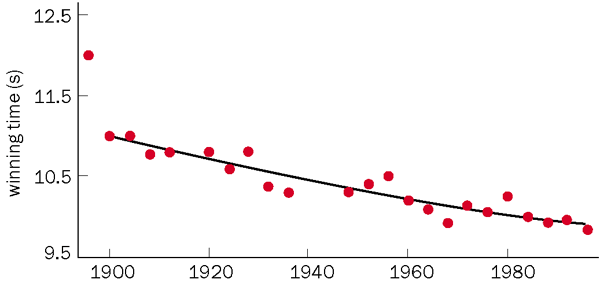Daniel Lenord
University of Alaska Fairbanks
Physics 211 Web Project, Fall 2002
| Index | 100-meter Dash | Javelin | Pole Vault | Bibliography | |

Olympic runner Jackie Joyner-Kersee at the start
In the modern Olympics, sprinters start from a crouching position, pushing against starting blocks to help them accelerate. Blocks were introduced in the late 1920s and were first used at the 1948 Olympic games in London. Instrumented starting blocks appeared in the early 1980s, and consisted of a spring plate and a microswitch. In the late 1980s units based on strain gauges emerged, although they were very sensitive to the push of the athlete against them and caused many wrong false starts in competitive races. An improved strain-gauge version that worked quite well was introduced in about 1993, and two years later an "intelligent" version was developed. It has a small module with a microcontroller built into the starting block and uses complex algorithms to eliminate false triggers. Starts are considered false if the athlete starts within 0.1 s of the firing of the starting gun - although the guilty athletes are no longer flogged!
The difference between winning and losing in sprinting is now so small that modern athletes obviously have to be timed as accurately as possible. Today's timing systems usually consist of a clock, which is triggered by the starter's gun, a light source, and an optical pick-up device that stops the timer when the winning athlete cuts the light beam. The light source is generally "modulated" - switched on and off - at frequencies of about 1000 Hz so that it is not fooled by changes in background-light intensity.
Tom Westenburg, who works as a principal engineer at the US Olympic Committee in Colorado Springs, helps the committee to develop electronics technology to aid elite American athletes. He has investigated the technological limitations of timing systems in the 100-metres sprint. For example, the timing device, which is typically a quartz oscillator, has to be stable to about 100 parts per million per degree kelvin to stop it losing accuracy as the temperature fluctuates. Westenburg has also shown that a modulation frequency of at least 4000 Hz must be used to ensure that the timing device is accurate to within one-thousandth of a second - as required for the 100-metre sprint. Fortunately such accuracies are becoming easier to realize than in previous decades thanks to improvements in microchip technology.

Winning times in the men's 100-metre sprint at the Olympic games from 1896 to 1996. The improvements are mostly due to better nutrition, physiology and coaching.
